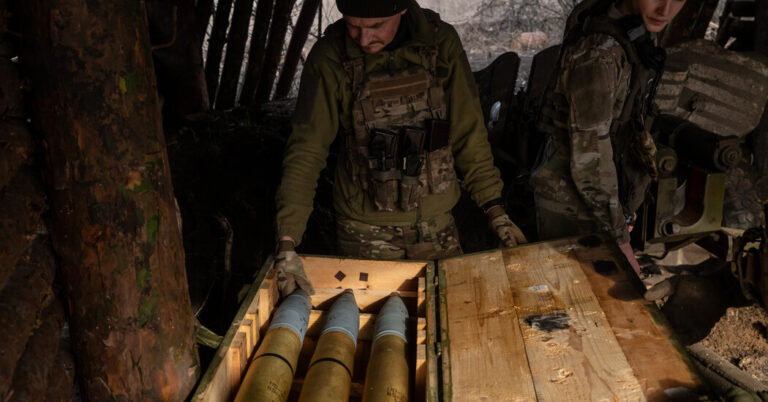With continued American aid to Ukraine stalled and the looming prospect of a second Trump presidency, NATO’s top diplomat said on Wednesday that the alliance was poised to take more control over military support sent to Ukraine — a role that the United States has played for the past two years.
Details are still being worked out, but Jens Stoltenberg, the NATO secretary general, said foreign ministers meeting in Brussels agreed to pursue plans to give the military alliance more oversight in coordinating security assistance and training for Ukraine.
Should the plan comes to fruition, it would represent a shift from NATO’s previous reluctance to be pulled more directly into the conflict and risk a severe military response from President Vladimir V. Putin of Russia. And it is not certain that NATO’s most powerful member, the United States, ultimately will agree to a measure that could dilute its influence.
But Mr. Stoltenberg said it was necessary to ensure that Ukraine could rely on NATO for years to come in a war with no immediate end in sight.
“The Ukrainians are not running out of courage — they’re running out of ammunition,” Mr. Stoltenberg said at NATO headquarters. “We need to step up now and ensure our support is built to last.”
He echoed impatience across the alliance with the United States’ delay in sending Ukraine a $60 billion aid package that congressional Republicans have stalled for six months. “We have a responsibility as NATO allies to take the decisions, and to ensure that the Ukrainians get the ammunition they must have, to be able to continue to push back the Russian invaders,” Mr. Stoltenberg said. “So it is urgent that the United States make a decision.”
One measure discussed at Wednesday’s meetings, officials said, would bring the Ukraine Defense Contact Group under NATO’s control. The group is currently led by the United States, and coordinates the donation and delivery of weapons to Ukraine’s battlefields.
Discussions are also underway about a plan floated by Mr. Stoltenberg to secure an additional $100 billion from the alliance’s 32 member states for Ukraine over five years. He called it obvious “that we need new and more money for Ukraine, and we need it over many years.” He added that he hoped to have final agreements by a July summit meeting of NATO leaders in Washington, where officials are expected to continue debating when Ukraine will be allowed to join the military alliance, as has been promised for years.
The United States and Germany insist that the government in Kyiv must make democratic and security reforms before it can become an alliance member. And few leaders are willing to bring Ukraine into the fold before the war with Russia is settled.
A NATO official confirmed the proposals, which were reported earlier by news outlets including Bloomberg News, but passage is by no means assured.
A second NATO official said that Hungary, where Prime Minister Viktor Orban has maintained warm relations with Russia, opposed the effort to put the Defense Contact Group under the alliance’s oversight. And several allies have questioned how NATO would be able to raise the $100 billion when it has no leverage over member states, the official said. Both NATO officials spoke on the condition of anonymity because the details of the plans have not been publicly released.
Biden administration officials also appeared dubious, although Secretary of State Antony J. Blinken did not publicly discuss the proposal to relinquish American leadership of the Defense Contact Group during remarks with Mr. Stoltenberg. A White House spokesman was careful not to say whether it would be supported or opposed in Washington.
The group of about 50 countries and international organizations “is bigger than NATO, it’s bigger than the alliance,” said John Kirby, a National Security Council spokesman. “And what brought them together was American leadership.”
Washington’s support for Ukraine has wavered in recent months, though the House speaker, Mike Johnson, is now expected to seek Republican approval for a version of the $60 billion aid package next week. The delay has infuriated Kyiv, irritated allies and prompted Mr. Stoltenberg to declare on Wednesday that it “has consequences” on the battlefield, where Ukraine’s forces are running out of artillery and air defense systems as Russia gains ground along the front line.
Concern is also growing among NATO allies over the possible re-election in November of former President Trump, who in the past has vowed to withdraw the United States from the military alliance and recently threatened not to defend Europe if it were under attack. Mr. Stoltenberg sidestepped a question on Wednesday about Mr. Trump, but said that “you need long-term planning” for NATO to continue supporting Ukraine.
In the two years since Russia’s full-scale invasion of Ukraine, the United States has led an effort to funnel more than $88 billion in weapons and security assistance to Kyiv through the Ukraine Defense Contact Group, which usually meets at an American air base in Ramstein, Germany. In addition to the NATO members, the group includes major allied nations, like Australia, Japan and South Korea.
It is not clear how the NATO alliance would work with nonmember states. But Mr. Stoltenberg noted that NATO states provide 99 percent of the military aid that Ukraine receives.
Ukraine’s foreign minister, Dmytro Kuleba, is scheduled to meet top NATO diplomats at headquarters on Thursday, the official 75th anniversary of the military alliance that was created at the start of the Cold War in a collective security pact against the Soviet Union.
Its latest member is Sweden, which abandoned decades of nonalignment after Russia invaded Ukraine in 2022. Sweden joined the alliance formally last month, and Wednesday was the first time its foreign minister, Tobias Billström, joined the diplomatic discussions as a full NATO member.
Matina Stevis-Gridneff and Michael D. Shear contributed reporting.

